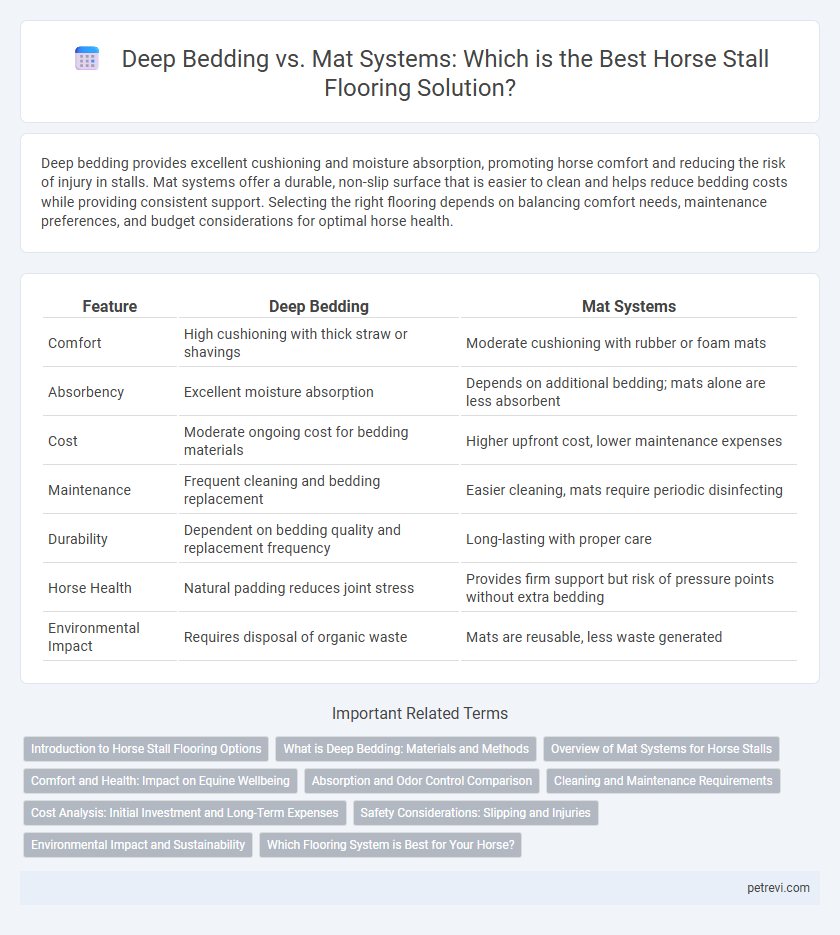Deep bedding provides excellent cushioning and moisture absorption, promoting horse comfort and reducing the risk of injury in stalls. Mat systems offer a durable, non-slip surface that is easier to clean and helps reduce bedding costs while providing consistent support. Selecting the right flooring depends on balancing comfort needs, maintenance preferences, and budget considerations for optimal horse health.
Table of Comparison
| Feature | Deep Bedding | Mat Systems |
|---|---|---|
| Comfort | High cushioning with thick straw or shavings | Moderate cushioning with rubber or foam mats |
| Absorbency | Excellent moisture absorption | Depends on additional bedding; mats alone are less absorbent |
| Cost | Moderate ongoing cost for bedding materials | Higher upfront cost, lower maintenance expenses |
| Maintenance | Frequent cleaning and bedding replacement | Easier cleaning, mats require periodic disinfecting |
| Durability | Dependent on bedding quality and replacement frequency | Long-lasting with proper care |
| Horse Health | Natural padding reduces joint stress | Provides firm support but risk of pressure points without extra bedding |
| Environmental Impact | Requires disposal of organic waste | Mats are reusable, less waste generated |
Introduction to Horse Stall Flooring Options
Horse stall flooring options significantly impact equine comfort, hygiene, and hoof health, with deep bedding and mat systems being the most popular choices. Deep bedding, typically made from straw or wood shavings, provides excellent cushioning and moisture absorption but requires frequent cleaning and replenishment. Mat systems, often composed of rubber or foam materials, offer durability, ease of maintenance, and consistent support, making them ideal for horses prone to joint issues or stall rest.
What is Deep Bedding: Materials and Methods
Deep bedding for horse stalls typically consists of thick layers of absorbent materials such as straw, wood shavings, sawdust, or shredded paper, providing a soft and cushioned surface. The method involves regularly adding fresh bedding on top of soiled layers, allowing manure and urine to be broken down naturally, which promotes comfort and hoof health. This approach enhances moisture control and insulation, creating a warm, dry environment that reduces the risk of respiratory issues and joint stress in horses.
Overview of Mat Systems for Horse Stalls
Mat systems for horse stalls offer enhanced comfort and shock absorption, significantly reducing joint strain and improving overall hoof health. Made from durable materials such as rubber or foam, these mats provide a stable, non-slip surface that helps prevent injuries and promotes better drainage. They require less bedding, making maintenance easier and more cost-effective compared to traditional deep bedding methods.
Comfort and Health: Impact on Equine Wellbeing
Deep bedding systems provide superior cushioning that reduces joint stress and enhances sleep quality, promoting overall equine health. Mat systems offer consistent support and easier cleaning but may lack the shock absorption needed for horses with sensitive limbs or arthritis. Optimal stall flooring balances comfort and hygiene to prevent hoof problems and ensure long-term wellbeing.
Absorption and Odor Control Comparison
Deep bedding systems excel in absorption by utilizing thick layers of materials like straw or shavings, which effectively trap moisture and reduce ammonia buildup, enhancing odor control in horse stalls. Mat systems, while providing a durable and easy-to-clean surface, rely on thinner bedding layers that often require frequent replacement to manage moisture and odors adequately. Studies indicate deep bedding offers superior odor mitigation due to its ability to envelop waste, whereas mats prioritize hygiene through rapid cleaning but may struggle with persistent ammonia levels without sufficient absorbent material.
Cleaning and Maintenance Requirements
Deep bedding systems demand frequent complete removal and replacement of straw or shavings to manage moisture and odor, requiring labor-intensive daily spot cleaning. Mat systems offer easier maintenance by allowing urine and waste to be scraped off surfaces quickly, reducing bedding use and minimizing ammonia buildup. Regular disinfecting and periodic deep cleaning of mats prevent bacterial growth and extend durability, making mats more manageable for consistent hygiene.
Cost Analysis: Initial Investment and Long-Term Expenses
Deep bedding systems demand higher initial investment due to substantial amounts of straw, shavings, or sawdust, yet offer enhanced comfort and natural absorption. Mat systems require upfront costs for durable rubber mats, but they reduce long-term expenses by minimizing bedding usage and simplifying stall cleaning. Evaluating cost-effectiveness involves balancing upfront material expenses against ongoing maintenance and bedding replacement requirements.
Safety Considerations: Slipping and Injuries
Deep bedding systems provide enhanced traction by absorbing moisture and reducing slippery surfaces, significantly lowering the risk of slips and injuries in horse stalls. In contrast, mat systems, while easier to clean, may become slick when wet or soiled, increasing the potential for falls and limb injuries. Selecting flooring that maintains consistent traction and cushioning is essential for promoting equine safety and preventing joint stress or tendon damage.
Environmental Impact and Sustainability
Deep bedding systems use large quantities of organic materials like straw or wood shavings, which decompose naturally and can be composted, reducing waste and promoting soil health. Mat systems, made from synthetic or recycled rubber, offer durability and less frequent replacement but may involve environmental costs related to production and disposal. Choosing deep bedding supports a more sustainable cycle through biodegradability, while mats provide long-term stall protection with a different ecological footprint requiring responsible end-of-life management.
Which Flooring System is Best for Your Horse?
Deep bedding systems provide superior cushioning and absorbency, promoting better hoof health and reducing the risk of injuries by allowing horses to nest comfortably. Mat systems offer easier cleaning and durability, with rubber mats providing a non-slip surface and consistent insulation, but may require additional bedding to enhance comfort. Evaluating your horse's specific needs, stall usage frequency, and maintenance capabilities will determine the optimal flooring choice for improved welfare and performance.
Deep Bedding vs Mat Systems for Horse Stall Flooring Infographic

 petrevi.com
petrevi.com